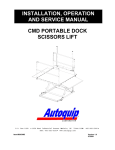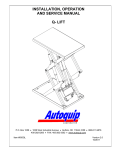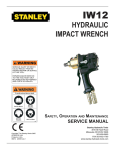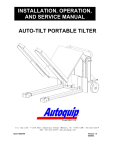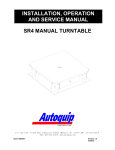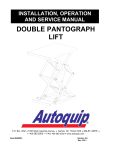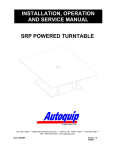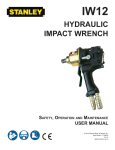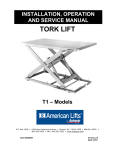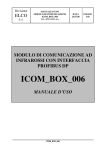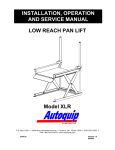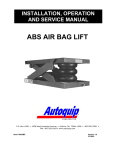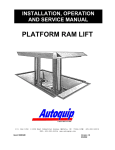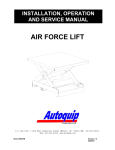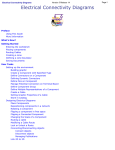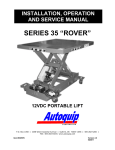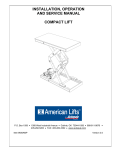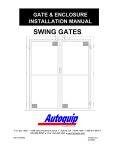Download Manuals - Autoquip Corporation
Transcript
INSTALLATION, OPERATION AND SERVICE MANUAL SPIRALIFT™ SCISSORS LIFT P.O. Box 1058 Item #830SL • 1058 West Industrial Avenue Guthrie, • OK 73044-1058 • FAX: 405-282-8105 • www.autoquip.com 405-282-5200 • Version 1.0 07/2001 TABLE OF CONTENTS Identification and Inspection 3 Dangers, Warnings, and Cautions 4 Label Identification 8 Specifications 11 Lift Blocking Instructions 12 Installation Instructions 14 Operating Instructions 18 Routine Maintenance 19 General Maintenance 21 Replacement Parts List 26 Troubleshooting Analysis 27 IMPORTANT Please read and understand this manual prior to installation or operation of this lift. Failure to do so could lead to property damage and/or serious personal injury. If any questions arise, call a local representative or Autoquip Corporation at 1-888-811-9876 or 405-282-5200. PLANNED MAINTENANCE PROGRAM A local Autoquip representative provides a Planned Maintenance Program (PMP) for this equipment using factory-trained personnel. Call a local representative or Autoquip Corporation at 1-888-811-9876 or 405-282-5200 for more information. 2 IDENTIFICATION & INSPECTION IDENTIFICATION When ordering parts or requesting information or service on this lift, PLEASE REFER TO THE MODEL AND SERIAL NUMBER. This information is on a nameplate attached to the leg assembly. Replacement parts are available from a local Autoquip distributor. INSPECTION Immediately upon receipt of the lift, a visual inspection should be made to determine that it has not been damaged in transit. Any damage found must be noted on the delivery receipt. In addition to this preliminary inspection, the lift should be carefully inspected for concealed damage. Any concealed damage found that was not noted on the delivery receipt should be reported in writing to the delivering carrier within 48 hours. The following is a checklist that will aid you in the inspection of this lift: 1. Examine entire unit for any signs of mishandling. Pay special attention to the drive mechanism, limit switches, and pushbuttons. 2. Thoroughly examine all connections, making sure they have not vibrated loose during transit, and inspect wiring for any signs of damage. 3. After installation, raise the lift and inspect the base frame, platform, scissors assembly, and spiral mechanism connections. 3 DANGERS, WARNINGS & CAUTIONS SAFETY ALERTS (Required Reading!) The following SAFETY ALERTS are intended to create awareness of owners, operators, and maintenance personnel of the potential safety hazards and the steps that must be taken to avoid accidents. These same alerts are inserted throughout this manual to identify specific hazards that may endanger uninformed personnel. Identification of every conceivable hazardous situation is impossible. Therefore, all personnel have the responsibility to diligently exercise safe practices whenever exposed to this equipment. ____________________________________________________________ DANGER! Identifies a hazardous situation that presents the imminent probability of death or of severe personal injury!! _____________________________________________________________ WARNING! Identifies a hazardous situation that has the potential of causing death or serious personal injury. CAUTION! Identifies a hazardous situation that could lead to the possibility of personal injury of death, and/or may result in equipment damage. _____________________________________________________________ 4 DANGERS, WARNINGS & CAUTIONS Read and understand this manual and all labels prior to operating or servicing the scissors lift. All labels are provided in accordance with ANSI Z535.4. DANGER! Do not work under lift without Maintenance Device! To avoid personal injury, NEVER go under the lift platform until the load is removed and the scissors mechanism is securely blocked in the open position. See "Lift Blocking Instructions" section. DANGER! To avoid personal injury, stand clear of scissors mechanism while the lift is in motion. DANGER! Do not install the lift in a pit unless it has a bevel toe guard or other approved toe protection. A shear point can exist which can cause severe injury to the foot. DANGER! HIGH VOLTAGE!! Disconnect and/or lock out the electrical supply to the power unit prior to any maintenance being performed. 5 DANGERS, WARNINGS & CAUTIONS DANGER! Scissors lifts are designed individually for a specific load and application. To avoid personal injury, do not change the load or application from the original design. WARNING! NEVER stand, sit or ride on the lift! WARNING! All warning and information decals should be in place as outlined in the “Label Identification” section. If decals are missing or damaged, they should be replaced with new ones. Contact Autoquip for replacements. WARNING! Do not attempt to remove the drive mechanism or drive belt until the maintenance locks securely support the empty lift. Failure to do so could results in personal injury or death! WARNING! Lift platforms traveling below floor levels my create openings, and the shape of the load and how the load is arranged on the lift may create a toe hazard as the load passes the top edge of the pit. Both situations may require guarding in accordance with Federal Regulations. Any such guarding must be installed prior to operating the lift. . 6 DANGERS, WARNINGS & CAUTIONS WARNING! When extended, the spiral column is held in compression by the weight of the lift platform. NEVER remove this compression! To do so can result in irreversible damage to the spiral mechanism. CAUTION! Do not continue to depress the “UP” button on the controller if the lift is not raising or if the lift has reached the fully raised position. To do so may result in permanent damage to the motor or pump. CAUTION! Precautions should be taken to prevent the introduction of contaminates such as dirt or other foreign material into the drive system through open fittings, pipes or disassembled components. Contamination will ruin the drive mechanism. CAUTION! At no time should the scissor table be raised by the platform. 7 LABEL IDENTIFICATION Figure 1 Label Placement Spiralift™ Scissors Lift Item No. Qty Description Part No. 1 2 Caution – Familiarize Yourself With Operators Manual 36401487 2 4 Danger – Do Not Put Hands or Feet . . . 36430050 3 1 Autoquip Serial Number Nameplate 36401511 4 2 Capacity 36401586 5 1 Danger – Do Not Disassemble Motor & Gearbox 36405110 6 2 Warning – Never Apply Side Load to Spiral Column 36403890 8 LABEL IDENTIFICATION Note: Labels shown here are not actual size. Figure 2 Label 36401487 Figure 3 Label 36430050 Figure 4 Label 36401511 9 LABEL IDENTIFICATION Figure 5 Label 36401586 Figure 6 Label 36405110 Figure 7 Label 36403890 10 SPECIFICATIONS Model Number Capacity (Pounds) Travel (In.) Lowered Height (Inches) Raised Height (Inches) Max End Load (lbs) Max Side Load (lbs) Standard Platform & Base Frame (Inches) Maximum Allowable Platform Size Stan. Raise Time (sec) Optional Raise Time (sec) Sh Wt 36SL25 2,500 36 9 1/2 45 1/2 2500 2500 24 x 56 48 x 80 18 12 70 36SL40 4,000 36 9 1/2 45 1/2 3000 3000 24 x 56 48 x 80 18 12 72 36SL60 6,000 36 9 1/2 45 1/2 3000 3000 24 x 56 48 x 80 24 12 75 48SL25 2,500 48 10 1/4 58 1/4 2500 2500 24 x 72 48 x 104 24 16 77 48SL40 4,000 48 10 1/4 58 1/4 2500 2500 24 x 72 48 x 104 24 16 80 48SL60 6,000 48 10 1/4 58 1/4 2500 2500 24 x 72 48 x 104 32 16 82 LOAD CAPACITY The load capacity rating is stamped on a metal plate attached to one side of the lift. This figure is a net capacity rating for a lift furnished with the standard platform. Where gravity roll-sections, special tops, etc, are installed on the lift after leaving the plant, deduct the weight of these from the load rating to obtain the net capacity. Lifts should not be overloaded beyond the established capacity as damage and/or personal injury may result. UNBALANCED LOADING The stabilization provided is basically for balanced loads. If special attachments extend beyond the length and/or width dimensions of the platform, the end and/or side load capacity is reduced 2% for each one-inch extension from the center. If the load is rolling onto the platform (in any but the fully-lowered position) the end and/or side load capacity is reduced by a 50% impact factor (i.e., divide the rated end/side load by 1.50 to establish an available “axle” load). 11 LIFT BLOCKING INSTRUCTIONS 1. Remove all load from the platform. Never block the lift when loaded. 2. Raise the platform sufficiently for the base rollers to rollback past the flip-over maintenance locks, located on the base frame of the lift. 3. Engage both maintenance locks by flipping them over (see Figure 8). 4. Lower the platform until the base rollers come into contact with and rest against the maintenance locks. Always hold the “DOWN” switch a few seconds more until all pressure is gone and the platform is supported entirely and safely by the maintenance locks. 5. Always shut off the main electrical switch, when blocked, to prevent someone from turning it on. DANGER! To avoid personal injury, NEVER go under the platform until the load is removed and the lift is securely blocked in the open position. 6. To remove the maintenance locks, raise the platform by activating the “UP” switch to provide sufficient clearance for the removal of the maintenance locks. DANGER! Maintenance locks that are bent, damaged, or non-functional must be replaced immediately to avoid personal injury. Contact the Autoquip Service Department for replacement parts and installation instructions. 12 LIFT BLOCKING INSTRUCTIONS FLIP-OVER MAINTENANCE LOCKS SHOWN IN PLACE ON BOTH SIDES OF BASE FRAME Figure 8 Maintenance Locks 13 INSTALLATION INSTRUCTIONS FLOOR INSTALLATION DANGER! Do not work under the lift without the maintenance device! To avoid personal injury, NEVER go under the lift platform until the load is removed and the scissors mechanism is securely blocked in the open position. See “Lift Blocking Instructions” section. 1. Make sure installation area is clean before starting. 2. If the permanent electrical work is not complete, some means of temporary lines with an on-off device for the power supply should be set up for testing purposes. 3. Place the lift in the installation area. CAUTION! When moving the lift, do not attempt to pick it up by the platform; it is hinged and could be damaged. Pick up the lift from under the base frame ONLY using lifting eyes or a strap sling. 4. Remove the shipping straps (the lift is shipped in a slightly raised position for checking rotation). 5. Check wiring connections to the motor for proper rotation of the spiral mechanism. 6. Make temporary electrical connections. Raise the lift just high enough to engage the safety locks. Once the “UP” limit switch is functional, raise the lift to the top of its travel. Make positioning adjustments and check for the proper height. If needed, shim to the desired height. DO NOT “Spot” shim. Shim the full length of the base frame. This will prevent the frame from sagging under an exceptionally heavy load. 14 INSTALLATION INSTRUCTIONS CAUTION! Over-travel of the spiral mechanism could cause permanent damage to the mechanism. Ensure that the “UP” limit switch is operational before raising the lift to a fully raised position. 7. The base frame of the lift has pre-drilled holes for lagging the lift securely to the floor. Mark the holes, drill, and install with anchors. Lifts with oversize platforms have minimum pullout requirements of 2,000 lbs. for each anchor. 8. Make permanent electrical connections and operate the lift through a few cycles. 9. Apply all warning labels in the correct location. See “Label Identification” section. 10. Clean up any debris from the area. A clean installation makes a good impression and creates a much safer environment. PIT INSTALLATION -- MODELS WITH BEVEL TOE GUARDS DANGER! Do not install the lift in a pit unless it has a bevel toe guard or other approved toe protection. A shear point can exist which can cause severe injury to the foot. 1. Check the pit dimensions. Length and width should be 2" minimum longer and wider than the lift platform. Depth should include _” allowance for shims or grout. 2. Check the chase entrance into the pit. The diameter should be 3". If the permanent electrical work is not complete, some means of temporary lines with an on-off device for the motor should be set up for testing purposes. 3. Lower the lift into the pit and check for proper height. The lift should be solid and flush with the pit angle framing. If needed, shim to the desired height. DO NOT “spot” shim. Shim the full length of the base frame. This will prevent the frame from sagging under an exceptionally heavy load. 15 INSTALLATION INSTRUCTIONS CAUTION! When moving the lift, do not attempt to pick it up by the platform; it is hinged and could be damaged. Pick up the lift from under the base frame ONLY using lifting eyes or a strap sling. 4. Remove the shipping straps (the lift is shipped in a slightly raised position for checking rotation). 5. Check wiring connections to the motor for proper rotation of the spiral mechanism. 6. Make temporary electrical connections. Raise and lower the lift to make positioning adjustments and align the platform in the pit with a proper clearance of 3/4” minimum around the edges from the platform to the pit angle. DANGER! Do not work under lift without Maintenance Device! To avoid personal injury, NEVER go under the lift platform until the load is removed and the scissors mechanism is securely blocked in the open position. See "Lift Blocking Instructions" section. 7. The base frame of the lift has pre-drilled holes for lagging the lift securely to the floor. Mark hoes, drill, and install with anchors. Lifts with oversize platforms have minimum pull out requirements of 2,000 lbs. for each anchor. 8. Make the permanent electrical connections and operate the lift through a few cycles. 9. Apply all warning labels in the correct location. See “Label Identification” section. 10. Clean up any debris from the area. A clean installation makes a good impression and creates a much safer environment! 16 INSTALLATION INSTRUCTIONS Figure 9 Top Plate Assembly & Limit Switch 17 OPERATING INSTRUCTIONS It is mandatory that all authorized maintenance and installation personnel become completely familiar with the contents of this manual before working on the Spiralift™. The following instructions were written to ensure safe and reliable operation of the lift. If the Spiralift™ is not maintained according to the instructions given in this manual, the warranty may become void by Autoquip. The Spiralift™ power unit is a very durable and dependable precision mechanism. It will give many years of trouble-free service if taken care of properly. It should be treated the same as any precision instrument. The upward and downward movement of the platform must not be restricted during operation of the Spiralift™ scissor table. The spiral mechanism is designed to “stack” under compression. If this compressive force is not maintained, the spiral may “unstack” and cause immediate and irreversible damage to the spiral mechanism. WARNING! When extended, the spiral column is held in compression by the weight of the lift platform. NEVER remove this compression! To do so can result in irreversible damage to the spiral mechanism. When the “UP” button is pressed, the coil of the motor starter will close the line contact permitting 3-phase electrical power to be applied to the motor. The rotating motor shaft is mechanically coupled to a gear reducer. The gear reducer has an output shaft with a belt drive system tied to the spiral mechanism. As the motor rotates, the spiral mechanism turns and “builds” a spiral column that raises the lift platform from beneath until the power is shut off by either releasing the “DOWN” button or until the lift makes contact with the “UP” limit switch. . Pressing the “DOWN” button will cause the reversing motor starter to engage and start the motor. The gear reducer and belt drive system now turn the spiral mechanism in the opposite direction, thereby “un-building” the spiral column causing the lift platform to lower until the power is shut off by releasing the “DOWN” button or until the lift makes contact with the “DOWN” limit switch. WARNING! NEVER stand, sit or ride on the lift! 18 ROUTINE MAINTENANCE Normally scissors lifts will require very little maintenance. However, a routine maintenance program could prevent costly replacement of parts and/or downtime. WARNING! To avoid personal injury, NEVER go under the lift platform or perform any maintenance on the lift until the load is removed and the scissors mechanism is securely blocked in the open position. See "Lift Blocking Instructions" section. MONTHLY INSPECTION 1. Lubricate the spiral mechanism (see recommendations in this section). 2. Check any unusual noise when it occurs. Determine the source and correct as necessary. 3. Check the snap rings at all rollers, if not in place, and/or secure, replace or repair immediately. 4. Check all rollers for signs of wear. Replace as necessary. 5. Do not grease roller or axles; they have lifetime-lubricated bearings. 6. Check all wiring for looseness or wear. Repair at once. 7. Check for metal particles or filings around the base of the spiral mechanism. 19 ROUTINE MAINTENANCE LUBRICATION CHART – SPIRAL MECHANISM Lubrication Or Solvent (Type/Specification) Manufacturer (see note) Ep Grease EP 2 Gear Oil API – GL1 or API – GL2 Mechanical parts cleaning solvent Various, except paint thinner Equipment or Component (When supplied) Pillow blocks, Zerk fittings Method of Application Use hand grease gun Vertical and horizontal bands Squirt with no excess on bands as they roll up to form the column Bearings, other bearing surfaces Squirt with no excess Drive, synchronizing chains Brush or wipe on sparingly Clean mechanical parts only (not for use on electrical parts) As required, wipe dry **Industry approved equivalents may be used except where manufacturer specifies otherwise. Failure to comply with the manufacturer’s specification could void the warranty. 20 GENERAL MAINTENANCE CAUTION! At no time should the scissor table be raised by the platform. Item Maintenance Task Corrective Action Spiralift™ drive chains Spiralift™ gearbox Check for excess slack and alignment Check the oil level of the gearbox 3 Drive belts 4 Check condition and tightness Check lubrication of the gears Driving pinion of the gearbox and ring gear on the Spiralift™ Vertical band and Check for rust or horizontal band accumulation of dirt of the Spiralift™ on the bands Retighten or realign; re-lubricate. Remove the top and side oil plug; add oil in the top opening until oil starts to flow from the side opening. Reinstall plugs. Retighten or replace as required. Clean and re-lubricate both gears. 1 2 5 Description 6 Inserting system 7 Vertical band magazine Check for loose screws on the vertical band inserting system and on the vertical band retainer. Make sure magazine is spinning freely with no friction due to dirt in the bearing. O/C D M S X X X X X X Clean and wipe the bands and spray gear oil on the bands, with no excess, as they roll up into the column structure. Tighten if required. Caution: All fasteners are assembled with “loctite”. X X X X Clean and lubricate magazine ball bearing system. X X Legend: O/C = On condition (when item becomes unserviceable; D = Daily; M = Monthly; S = Semi-annually; A = Annually. If over one year, maintenance interval will be specified. 21 A GENERAL MAINTENANCE REPLACING THE SPIRAL MECHANISM 1. Raise the scissors table three to four feet and block it securely (see “Lift Blocking Instructions”). 2. Remove the spiral mechanism by disabling the security switch and then disconnecting the top plate from the scissors table. Allow the mechanism to unbuild back into the storage canister. 3. Install the new motor on the base plate. Install the pulleys on the motor and the gearbox drive shafts. 4. Position the Spiralift™ on its base plate in the scissors lift table. Make sure that the center of the Spiralift™ and center of the nesting are aligned to ensure the Spiralift™ is plumb properly during its travel. 5. Level the Spiralift™. 6. Turn the Spiralift™ manually by inserting a _” diameter bar in the holes of the head. Move the top plate two turns up. 7. Install the “V” belts on the motor and gearbox pulleys 8. Connect the motor to a power source and jog the control push buttons to check the rotation of the Spiralift™. 9. Manually lower the platform of the scissors lift table onto the Spiralift™ top plate making sure it is properly inserted into the nesting. 10. Raise the platform two feet. 11. Carefully inspect the extended column of the Spiralift™ to ensure that the vertical band is properly seated in the groove of the horizontal band throughout. 12. Run the Spiralift™ through several cycles making sure that to stay at least four inches away from the upper and lower end of the travel of the Spiralift™. If it does not run fully plumb, level the Spiralift™ and/or move the base plate in line with the nesting. 22 GENERAL MAINTENANCE 13. Readjust the upper and lower limit switch. This will stop the electric motor. The lifting unit has a mechanical stop at each end of the travel. This is done so the Spiralift™ will not be driven out of the travel limits for which it was designed, thus avoiding serous damage. 14. Enable the security switch on the scissors lift to detect the loss of contact between the Spiralift™ to plate and the lift tabletop plate. This security switch will stop the Spiralift™ until if the contact is lost (see Figure 9). 23 GENERAL MAINTENANCE Figure 11 Electrical Schematic 24 REPLACEMENT PARTS LIST LIFT PARTS PART # DESCRIPTION 20022158 14DU12 Bushing 20022851 18DU12 Bushing 20022877 18DU16 Bushing 20023966 24DU24 Bushing 24001018 MolyKote Washer, 7/8” id x 1/64” thick 24002016 MolyKote Washer, 1 1/8” x 1/64” thick 24008013 MolyKote Washer, 7/8” ID x 1/32” thick 24094518 Plastic Washer, 1 1/2” 34000018 Limit Switch 34000257 Limit Switch Arm 35103380 Foot Switch and Guard 35107980 Control Panel 230V/3PH 35107990 Control Panel 460V/3PH 36201730 Pushbutton Assembly, NEMA-4, Pendant with magnets 45400082 Retaining Ring, 1 1/8” 45400215 Retaining ring, .7/8” 52500253 Roller Pin, 1 1/8” diameter x 1 3/4” long 52502705 Clevis Pin, 1 1/8” diameter x 2” long 52504630 Roller Pin, 7/8” diameter x 1 _” long (36S15) 52504780 Clevis Pin, 7/8” diameter x 1 _” long (36S15) 52600269 Roller Assembly, 3” OD x 1 1/8” ID SPIRAL MECHANISM PARTS See accompanying GALA Manual for parts list. Contact GALA directly for parts replacement assistance. 25 TROUBLESHOOTING ANALYSIS DANGER! To avoid personal injury, NEVER go under the lift platform until the load is removed and the scissors mechanism is securely blocked in the open position. See "Lift Blocking Instructions" section. PROBLEM Platform jams during downward stroke. Stop the lift immediately if it has not already stopped automatically. POSSIBLE CAUSE AND SOLUTION • If the top plate of the column is still in its pocket under the top platform and the vertical band is still in the groove of the horizontal band, the lift may be jogged up until the column bears the weight of the table. Remove the load from the platform and remove the source of the obstruction. Carefully inspect the extended column of the lift to ensure that the vertical band is properly seated in the groove of the horizontal band throughout. Lower and raise the table once with no load. • The top plate of the column has come out of the pocket of the top platform and the column has rotated so that the top plate is no longer aligned with the pocket, but the vertical band is properly seated in the groove of the horizontal band. Block the platform in its position and verify that the platform won’t move. Remove the load. Rotate the column from the top plate, by hand, maintaining a downward pressure until the top plate is aligned with the pocket on the underside of the platform. It is advisable to use some weight (50 pounds) over the top of the column to perform this operation until it is brought close to the top platform. Jog the lift drive upward until the top plate enters the pocket and bears the weight of the load. Proceed with the corrective measures described above. 26 TROUBLESHOOTING ANALYSIS PROBLEM POSSIBLE CAUSE AND SOLUTION Platform jams during downward stroke. Stop the lift immediately if it has not already stopped automatically (continued from previous page). • The column has lost its integrity (i.e., the vertical band has come out of the grove in the horizontal band.) Block the platform in its position. Remove the load. Feed the two bands back into their respective storage position by rotating the head of the column. If this is difficult, remove the retaining screws at the top end of the vertical band and then feed the two bands back down individually. When the horizontal band and the head assembly are at the bottom and the vertical band is in the magazine, re-attach the vertical band to the head assembly and reinsert the retaining screws. Rotate the column assembly up, by hand, by rotating the top plate slowly. Proceed with the corrective measures described above. One of the driving belts on the drive unit is broken. • If at any time one of the driving belts breaks loose, the platform movement will stop automatically. A proximity switch senses the broken belt and the platform will not move until this belt is replaced. Block the platform in its position. Remove the load. Verify that the platform won’t move. Remove the belt guard and replace both belts. If the column has been lowered away from the top platform, re-insert the top plate of the column into its pocket according to previous steps described. 27




























